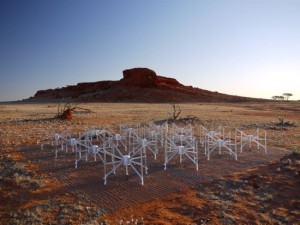
A station with 16 antennas, one of 256 comprising the MWA. Image: Curtin University; MWA
Astronomers are using the MWA to make a detailed map of the entire southern radio sky. They are also using it to make observations of hydrogen gas from an epoch of the Universe when the first stars and galaxies were forming; study the Milky Way Galaxy’s magnetic field; and investigate radio sources like pulsars, X-ray binary stars and neutron stars.
“The original MWA opened our eyes to a new view of the radio sky,” says Prof. Bryan Gaensler, Director of the Dunlap Institute for Astronomy & Astrophysics, and Canadian representative on the MWA Board of Partners. “This upgrade greatly sharpens that view, and allows us to study in detail the new objects that the MWA discovered earlier.”
The MWA is one of four precursor telescopes for the Square Kilometre Array (SKA) which, when completed in the mid-2020s, will be the largest radio telescope ever built. It will have a total collecting area of a square kilometre, with antennas located in Australia and South Africa. SKA will be a ground-breaking instrument which astronomers will use to conduct new tests of General Relativity, observe the very first stars and galaxies, and investigate dark energy and cosmic magnetism.
The MWA upgrade marks the completion of Phase Two in its development with the addition of 128 new antenna stations to the existing 128. Each station comprises 16 antennas for a total of over four thousand antennas arranged within an area with a diameter of roughly six kilometres.
The array is located at the Murchison Radio-astronomy Observatory in Western Australia and is operated by an international consortium led by Curtin University and which includes partners from Australia, India, New Zealand, China, the United States and Canada. The University of Toronto officially joined the consortium in June 2016
“The MWA is not only an amazing scientific facility in its own right,” says Gaensler, “but it is a vital stepping stone and test-bed for our even more ambitious plans for the SKA.”
Additional notes:
1) The Phase Two expansion of the MWA was partly funded by a $1 million grant as part of the Australian Research Council (ARC) Linkage Infrastructure, Equipment and Facilities (LIEF) scheme. A further $1.2 million has been provided by partner institutions.
-30-
Curtin University MWA Phase ll press release
Murchison Widefield Array website
SKA Canada website
CONTACT INFORMATION:
Prof. Bryan Gaensler, Director
Dunlap Institute for Astronomy & Astrophysics
University of Toronto
p: 416-978-6223
e: bgaensler@dunlap.utoronto.ca
w: http://www.dunlap.utoronto.ca/prof-bryan-gaensler
Chris Sasaki
Communications Coordinator | Press Officer
Dunlap Institute for Astronomy & Astrophysics
University of Toronto
p: 416-978-6613
e: csasaki@dunlap.utoronto.ca
The Dunlap Institute for Astronomy & Astrophysics at the University of Toronto is an endowed research institute with nearly 70 faculty, postdocs, students and staff, dedicated to innovative technology, ground-breaking research, world-class training, and public engagement. The research themes of its faculty and Dunlap Fellows span the Universe and include: optical, infrared and radio instrumentation; Dark Energy; large-scale structure; the Cosmic Microwave Background; the interstellar medium; galaxy evolution; cosmic magnetism; and time-domain science.
The Dunlap Institute, Department of Astronomy & Astrophysics, Canadian Institute for Theoretical Astrophysics, and Centre for Planetary Sciences comprise the leading centre for astronomical research in Canada, at the leading research university in the country, the University of Toronto.
The Dunlap Institute is committed to making its science, training and public outreach activities productive and enjoyable for everyone, regardless of gender, sexual orientation, disability, physical appearance, body size, race, nationality or religion.
###
